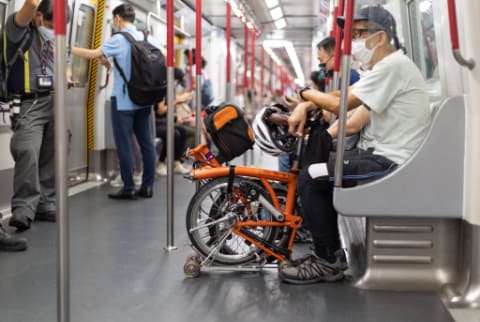One of the primary reasons why people choose a folding bike is because it’s easier to travel with. When you want to take it on public transport or a plane, you must fold the bike into a compact package. When you arrive, it will often take 30 seconds to unfold and start riding again.
But there are several things to remember when traveling with a folding bike.
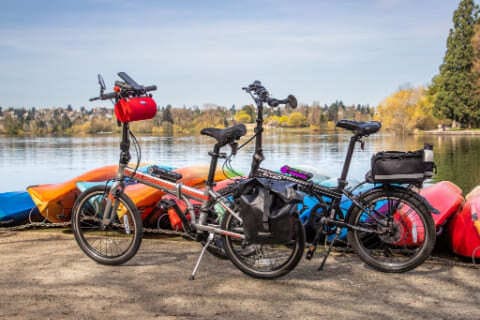
Each transport method will often have a few unique considerations to bear in mind. Please keep reading to learn everything you need to make sure that your folding bike arrives at its destination safely.
Transporting a Folding Bike in A Car
One of the most popular transport options is putting folding bikes into the car. There are a few places where you can set up the folding bike. The most popular options are:
- Putting your foldable bike in the boot of the car
- Putting it in the backseat
- Using a bike rack. This can either be attached to the roof or the car’s rear.
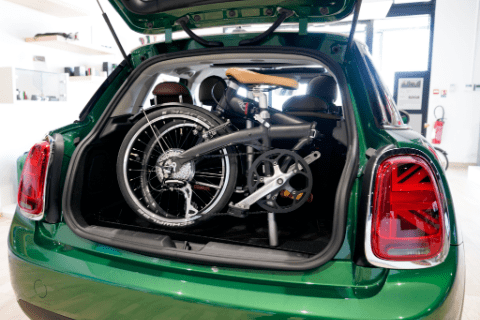
Since most folding bikes will end up the same size as a suitcase, you shouldn’t have any problems fitting them in the car. There are a few important things to keep in mind to avoid damaging the folding bike:
- Lean on the folding pedal side. On most folding bicycles, there will be one pedal that will fold down. This will allow you to lie your bicycle flat in the car. This limits the bike’s movement in the vehicle and ensures that you aren’t putting any pressure on the pedals.
- Secure the bike. Make sure that you secure your bike in your car. This ensures that it doesn’t fall over when you brake suddenly. You can secure it by putting it in your car seat and using the seatbelt. Another option is to slide the passenger seat back as far as it will go. This will create a narrow gap between the back of the passenger seat and the rear seats, which should fit your bike snugly.
- Protecting the bike. You don’t want dirt to enter the folding mechanism or gears. If you place the folding bike in the boot of your car or the rear seat, this shouldn’t be an issue. But if you are planning on putting it in the tray of a Ute, you might need a little more protection. You can cover it with a tarp or blanket.
If you are going on a driving holiday, you might have to store a lot of luggage in the car. In this case, it’s best to put the folding bike on top of the other bags to prevent the weight from damaging the frame.
Traveling on Public Transport With a Folding Bike
Sometimes, you only want to ride part of the way and take public transport for the next leg of your journey. The good news is that boarding public transport with a foldable bike is very easy.
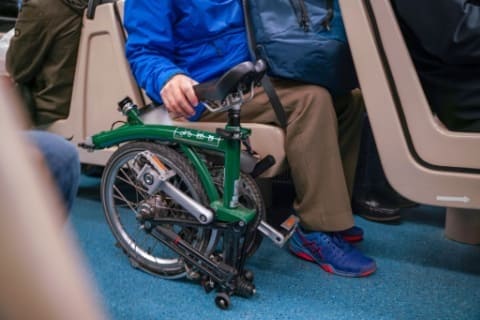
However, before you board, there are a few regulations that you should be aware of; these include:
- Size restrictions. Some cities might limit the size of the package you can take on public transport. Though they usually don’t enforce this policy too strictly, as long as the size of the folding bike doesn’t disturb the other passengers.
- Coverings. Depending on your traveling location, you might need to cover the folding bike on public transport. Though this usually isn’t required. But you will need to be careful about the handlebars and pedals. On some models, these can stick out a little. You don’t want to bump into other commuters with these sharp sections accidentally. Some people prefer to put their bikes into a large shopping bag, like the ones available from IKEA.
- Wipe down your bike. If it’s been raining or wet, you might want to wipe your bike down before you get on public transport. This will eliminate any mud and water, which is courteous for other commuters.
When you fold your bike, it will make a highly compact package. In most cases, it will be a little larger than a suitcase. It’s often easier to grip it around the steel frame rather than holding it by the handlebars. This will allow you to carry it onto any public transport mode easily.
Once you are on the transport, you might be able to slide it underneath your seat.
This prevents the bike from irritating other passengers. At other times, there might be some overhead spaces for you to store luggage during the trip. If not, you can place it close to your side. To learn more about the correct etiquette, check out this post on how to take a folding bike onto the tube.
The only downside to this type of transport is that folding bikes can get heavy if you need to carry them long distances.
This is most common if you must walk along an extended platform to get to your transport. To solve this problem, you might be able to leave the seat pillar extended, allowing you to roll the bike by your side.
Transporting Folding Bikes On Buses
Sometimes, you will want to take a long bus journey with your folding bike. In this case, you will need to store your folding bike in the luggage component of the cycle. As you do this, there are a few regulations that you will need to consider:
- The number of bags allowed. A folding bike will often be counted as a bag by the bus company. Most of the bus lines in the US qualify for one check-in bag and one carry-on bag.
- Weight limit. Most major lines will have a maximum weight limit of 50 pounds on check-in bags. Thankfully, most folding bikes should come in under this limit.
- Size of the package. Usually, you will be able to have a maximum package size of 62 inches. Again, most folding bikes will be under this limit, so you don’t have anything to worry about.
If traveling by bus, you should take a few protections when traveling with your folding bike so a reckless driver can’t load it incorrectly and damage the frame.
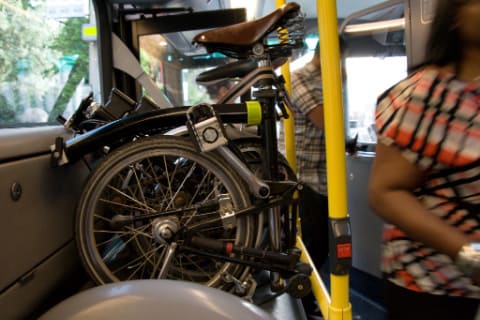
It’s best to put it in a hardshell case, protecting it from any bumps in the road. You can refer to this guide on whether you can take a folding bike on a bus to learn more.
Transporting a folding bike on a train will be similar to taking it on the bus.
The line you travel with will determine your weight limit. Though most will allow you to take two pieces of luggage and have a weight limit of 50 pounds. If it’s over this limit, you will have fees. If you want to learn more, this resource explores transporting a bike on a train.
Flying With a Folding Bike
One of my favorite advantages of having a folding bike is quickly putting it onto a plane. Here are a few logistics to consider as you fly to ensure the cycle reaches its destination in good condition.
The first consideration is how you will prepare the bike.
It’s best to put it into a hardshell suitcase. This will provide insulation from any knocks received during the baggage handling process. You might be able to find a dedicated bike bag.
These will often contain straps that you can use to hold the bike components in place.
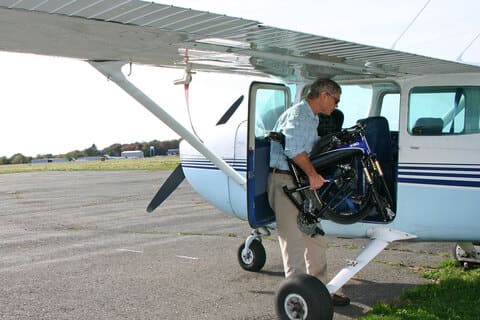
Air travel can require more jostling movement than other forms of transport, like buses.
There are even videos of baggage handlers throwing suitcases onto conveyors leading to the plane. Because of this, you might want to put some padding in the suitcase.
This can be as simple as filling gaps between the components of your clothes. This will stop them from moving around too much as they get loaded into the plane, helping to limit the damage.
Another option is to get some pipe insulation from your local hardware store.
This is soft foam with a hollowed middle. You can cut a slit on the side, sliding it onto your bike’s frame. Rubber bands can be used to hold the pipe insulation in place. You can also cut a hole into the base of a tennis ball and place it over the seat pillar.
Here are my tips on what you should bear in mind when preparing your folding bike for the flight:
- Deflate your tires. This will ensure the tires aren’t affected by changes in air pressure. You might want to leave a small amount of air in the tires. This can provide some cushioning to protect against damage to the rim.
- You might need to disassemble your bike. Sometimes, you will need to disassemble the bike a little to ensure that all the parts fit into a compact suitcase. Often, this will mean removing the seat post and lying next to the bike. You might also need to take the wheels off.
So far, we’ve looked at ways you can check your bike and fly easily.
Though some people will want to bring their bikes as a carry-on. While this approach will allow you to watch over the cycle during the trip, it isn’t recommended. There are a few reasons to avoid this approach, they include:
- Folding bikes can be too heavy for carry-on. This may result in you needing to pay additional fees.
- Passing through security. Though your bike shouldn’t contain prohibited items, it will be an unusual sight. Because of this, security officers might spend a little more time inspecting the bag to ensure everything is up to standard. Plus, you’ll face questions from airport staff.
- Stowing the bike can be tricky. Most of the time, a folding bike can fit in the overhead luggage compartments. But it will take up a lot of space. This can prove to be irritating to other customers. Sometimes, the overhead bins will be packed, and you must gate-check the bike. This means that it will be put into the plane’s hull and returned to you at the end of the flight.
- Not all folding bikes can be carried on. You will often need to have wheels smaller than 20-inches for the bike to be compact enough to be considered a carry-on.
If you take a folding bike as a carry-on, you should still put it in a suitcase or bag. This will help avoid questions from confused airport staff or fellow passengers. Plus, a hard-shelled bag will add a layer of protection.
Fees Associated with Taking a Folding Bike on a Plane
One of the most significant downsides of flying on a plane is the chance of having to pay extra fees to transport your folding bike. The costs will depend on how you transport the folding bike.
The folding bike might exceed weight limits if you want to take it as a carry-on.

Because of this, you might need to pay additional fees. Or you will need to check the folding bike, resulting in an excess baggage charge.
If you are always going to check the bike, you shouldn’t have too many problems.
Most people report that airlines aren’t too strict with enforcing the rules. Most airlines won’t charge any fees for folding bikes. Though you should always check the size and weight limits before you fly.
Remember, these rules will vary from airline to airline.
If you want some tips to ensure that you don’t pay anything, it’s worth reading this post about how to take a folding bike on a plane without paying for excess baggage.
Taking A Folding Bike On A Cruise Ship
Foldable bikes are a practical option for cruises because they’re compact and lightweight, which makes them easier to store and transport. If you would like to dig deeper then please check out my taking folding bikes on cruise ships guide.
What To Take On A Longer Trip?
Properly packing your folding bike is essential. But on a more extended trip, you should also consider what you will need to take to keep the folding bike in good condition.

Some of the essential tools you should take include:
- Pump. Depending on airline rules, you might have to deflate your tires a little before you fly. Because of this, you should bring a small pump with you.
- Cloth. If the bike gets wet, it’s a good idea to wipe it down before you put it into the bag. This will stop rust and mold from forming.
- Tire patch kit. This can help stop a minor puncture from turning into a significant issue.
- Helmet. This is a vital piece of safety kit. In many countries, it is illegal to cycle without one. You might also want to add a drink bottle and your riding clothes.
In most cases, you should pack light when going on a folding bike holiday. If more substantial repairs are needed, like replacing a tire, you should try to find a local bike shop that can help.
What Bags To Put A Folding Bike Into When Traveling?
As we’ve mentioned, the most common option is to put your folding bike into a hardshell suitcase while traveling.
This should fit most bikes. If you are wondering whether your model will work, this post has more information about which folding bikes fit in a suitcase.
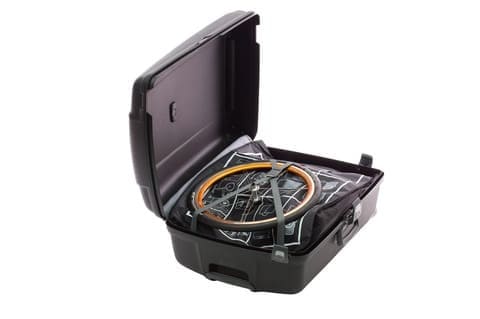
However, this isn’t the only option that you can explore. Here are some of the other things you can consider:
- Bike bags. Some folding bike manufacturers, like Brompton, make their own carrying bags. These are big enough to carry a folding bike, though you might need to do some preparations, like removing the seat or adjusting the handlebars.
- Using the original box. Another option to explore is putting the bike into the original box. These tend to be pretty compact, so you shouldn’t have to pay any excess fees if traveling by air. The only problem is that you can’t lock your luggage to prevent theft.
- Cycling bag. This plastic bag goes over your bike and is the least preferable option because it provides minimal protection.
- Large plastic shopping bag. Some stores, like IKEA, will have big plastic bags. These should be large enough to hold a folding bike. This can be a good home storage option and can also come in handy if you are going on public transport and want something with handles to help you carry your bike. But I wouldn’t recommend it for a longer trip, like going on a bus or flying.
- Hard-shell suitcase. This is the best option, protecting from knocks and bumps while remaining easy to lift and carry.
Final Thoughts
Folding bikes are lauded for their compact nature, making them significantly more straightforward to transport than conventional models. But there are still a few things to remember, like using a tennis ball to guard the seat pillar.
Thankfully, as long as you follow these tips, your folding bike will arrive at its destination in excellent condition.

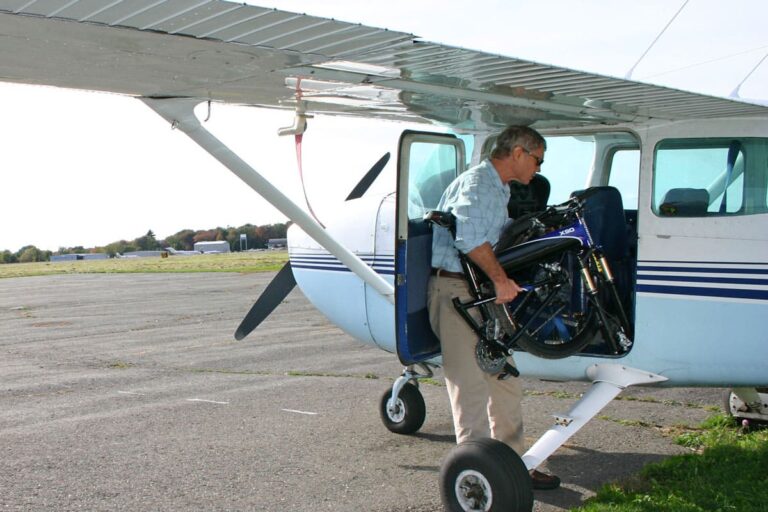
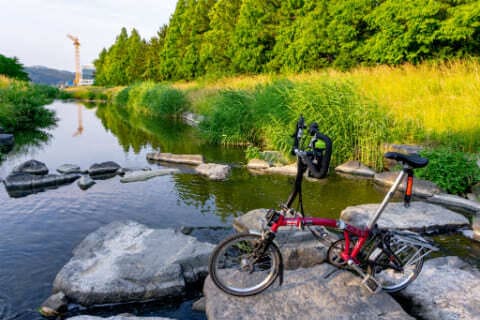

![How Much Do Folding Bikes Weigh in [year]? Weight Limits Revealed](https://www.foldingbikeguy.com/wp-content/uploads/How-Much-Do-Folding-Bikes-Weigh.jpg)
